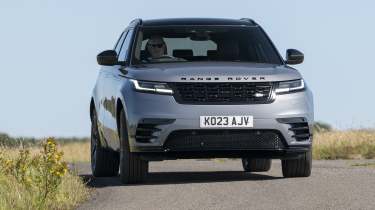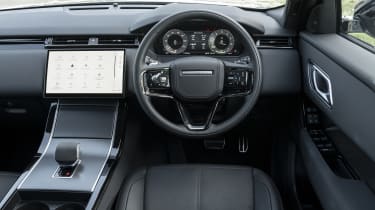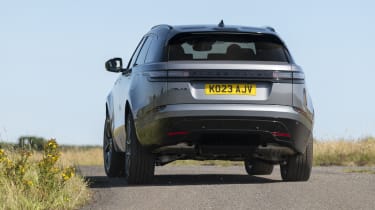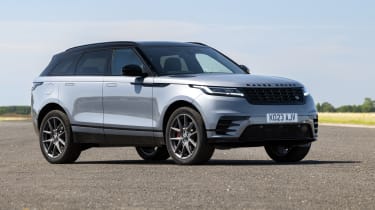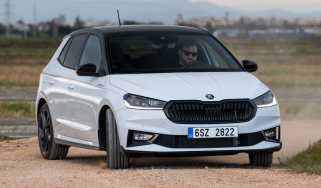Range Rover Velar P400e 2024 review – luxury SUV eyes Mercedes-Benz GLC
Range Rover’s entry-level SUV still has plenty to offer above its traditional rivals, and hybrid power provides a genuine real world practicality
After seven years, Range Rover has given its Jaguar F-Pace-based Velar an update. Those who follow product life cycles closely will clock that that is a time frame when most OEMs would retire the original and present a whole new car. Not the House of Brands, sorry JLR. Like the Evoque it sits above in the product hierarchy, the Velar comes under the header: if it ain’t broke, don’t fix it. There’s also the small issue that the Velar is based very heavily on Jaguar’s F-Pace, which despite still being considerably better to drive, more practical and more stylish than its rivals even after eight years in production, will also soon be retired before Jaguar goes all electric; no all-new F-Pace means no all-new Velar.
While not as ubiquitous as its bigger brothers, nor as successful, the Velar, like the Jaguar it shares so much with still drives better than the majority of its rivals, if lacking when it comes to the cutting edge tech that manufacturers think new car buyers care about.
> The new Porsche Macan kick starts the firm’s next generation of EVs
This latest Velar update is a subtle one, rather than ground breaking. The simple exterior bodywork has been left alone, leaving the elements that are accessible to update within the confines of a small budget to take focus. There are design tweaks to bumpers, grilles and lights and new wheel designs. It’s oh so subtle and will know doubt keep the Velar faithful content, if not leave a few asking where’s the progress…
Inside, the changes are more substantial and might cause a bit of consternation, primarily because all the physical buttons and switches have gone, leaving a minimalist centre console with a touchscreen to control everything. Oh.
It’s not the total disaster you might be expecting, because Range Rover’s latest HMI software is quick and intuitive to use, even when it comes to temperature controls. But while the clean transmission tunnel allows for an unbroken surface, it does look a little bare and too simplistic; a little try hard to up the luxury and ironically an F-Pace still feels plusher. And adjusting the volume via a touchscreen will never be as intuitive as a rotary control.
Fit and finish remains high, although not to Range Rover Sport levels, and the multiple materials used throughout the cabin marks the Velar out as a step above the competition. That well worn trope of premium luxury used by others genuinely applies here. Then again, for £68,000 so it should.
A selection of petrol and diesel engines (remember those?) are available with four or six-cylinders, with the plug-in hybrid tested here only available with a 2-litre four-cylinder petrol motor. On its own it produces 263bhp and is supplemented by a 141bhp electric motor powered by a 19kwh battery, making for 404bhp and 472lb ft potential output. Range Rover claims a 38 mile electric range, a 140mph maximum speed and a 5.1sec 0-60mph time.
The hybrid powertrain is well integrated with seamless switching between the two power sources, and the real world range, even in cold weather, is close to the claimed figure – 30 miles is easily achieved in mixed driving. Once the battery is empty, though, the regen capability never meaningfully charges the battery, leaving you to rely on the 2-litre motor alone. It’s a willing engine, if a little coarse when pushed, which is required when the battery is depleted and that electric torque surge has faded, but it’s responsive, smooth revving and unobtrusive. A supercharged V8 it is not, but then it also doesn’t require you to stop so frequently for fuel, with 35-37mpg our average over a 500-mile week of mixed motoring.
Underpinned by the same aluminium suspension as the F-Pace means there’s a higher degree of calmness to the Velar’s road manners that its German rivals can’t match. There’s a linear flow in everything it does, the coil springs when matched to the optional adaptive dampers of our test car deliver a pliancy and level of comfort that some models from the class above struggle to match. It’s never going to deliver a thrill from behind the wheel but the Velar is remarkably refined, providing a level of luxury that’s a cut above its direct rivals.
It’s practical too, with plenty of space that some competitors forgot is the reason many buy a car from this class, ergonomically simple to operate and the steering wheel controls making up for the lack of physical switches.
In a world dominated by Range Rover, Range Rover Sport and Defender sales, cars such as the Velar go under the radar. It doesn’t drive as well as a Porsche Macan but has more space, more practicality and feels more special. The offerings from Audi (Q5 and no plug-in hybrid option), BMW (X3) and Mercedes (GLC) might be more advanced products in terms of the technology, and start at a cheaper price point, but their ubiquitous nature means they lack the appeal of the junior Range Rover.
Prive and rivals
Sitting down? Good, because the Velar isn’t cheap. The Dynamic SE starts at £68,805 and it’s easy to add over £5000 to that in options, despite the generous standard kit: heated windscreen, auto-high beam assist, a 10 feature strong driver assistance package, adaptive cruise and hill descent control, hill launch assist and low traction launch and Range Rover’s All Terrain Progress Control software are all included. Plus 14-way adjustable front seats, wireless charging, power tailgate, Apple CarPlay and Android Auto, Land Rover’s Pivi Pro operating system and home and public charging cables.
Heated and cooled seats are a £440 option and a secure tracker is £340 (handy in the current JLR climate). Configurable dynamics cost £635 as part of the dynamic handling pack and the sliding panoramic roof will set you back an additional £300. The big options to tempt you include the £1010 cold climate pack (heated power wash and heated rear seats to go with the heated and cooled front chairs).
Jaguar’s F-pace with the same 2-litre turbocharged four-cylinder hybrid powertrain starts at £61,335i, with BMW’s X3 xDrive 30e xLine starting from £56,515 and the Mercedes-Benz GLC 300 e 4Matic Urban Edition from £58,710.

